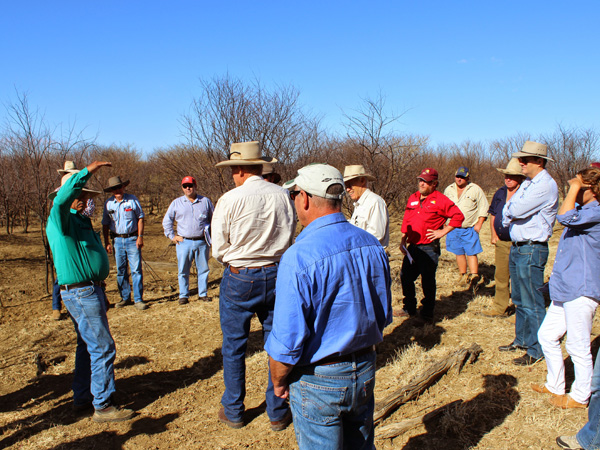Weed control increases carrying capacity
By Mark Kleinschmidt, Desert Channels Group
New generation prickly acacia control is leading to remarkable improvement in ground cover, land health and carrying capacity in the Mitchell grass country of Queensland’s west.
Twenty years of business as usual has seen QLD’s prickly acacia infestations triple to 23 million hectares; without a dramatic breakthrough, 95 percent of the Mitchell Grass Downs will be impacted by 2030.
That dramatic breakthrough has come from Longreach-based natural resource management group, Desert Channels Queensland, whose ground-breaking new techniques and technologies perfected over the past three years has seen a 15-fold increase in grass biomass at one monitoring site near Aramac.
CEO Leanne Kohler said while this was boosted by drought-breaking rain, even during the drought, the site had shown a five-fold increase in grass biomass.

Graziers inspecting a treatment site discuss the program.
“Before we treated this site, it was fairly dense prickly acacia with very little ground cover… around 100 kilograms per hectare biomass,” she said. “A year later it was 500, and it’s now 1,500 kilograms per hectare.”
Figures from Mackey (1996) shows pasture production is halved by a 20 percent canopy of prickly acacia, while virtually all pasture growth is prevented by a canopy cover of 50 percent; it shouldn’t be unexpected that removing the prickly acacia delivered this result. What is surprising is the way it has been done.
“We use time-series satellite mapping to identify the prickly acacia hot spots in the landscape, then we match treatment techniques to infestation densities, treating the really dense stuff with a helicopter drone,” Leanne explained.
“Two additional keys to our efficiencies are an Area Management Plan under the Vegetation Management Act where we can kill immature natives in the course of treating prickly acacia, as long as we preserve the mature natives – and a federal permit to use tebuthiuron in ephemeral watercourses.”
These two regulatory tools can only be activated by a DCQ 5 Year Weed Plan, which must be monitored by DCQ.
Having redrawn what effective prickly acacia control looks like in western QLD, DCQ is still engaging landholders in control agreements, while their field team continues to knock out ultra-dense infestations in riparian areas, enabling the landholders to clear their paddocks in the knowledge that the major seed sources are gone.
Of no less significance in this list of achievements is the mindset change. Historically, people spoke of the need to ‘control’ prickly acacia, which was likened to having a test cricket match-plan of not allowing the opposition to score too many runs, rather than aiming to bowl them all out.
Language dictates mindset.
Control is not a word DCQ uses any more. Now, the talk is of eradication. It may only be one paddock at a time, one property at a time, one creek at a time, one catchment at a time, but they are eradicating prickly acacia.
For more information, contact the Desert Channels Group on (07) 4658 0600.



